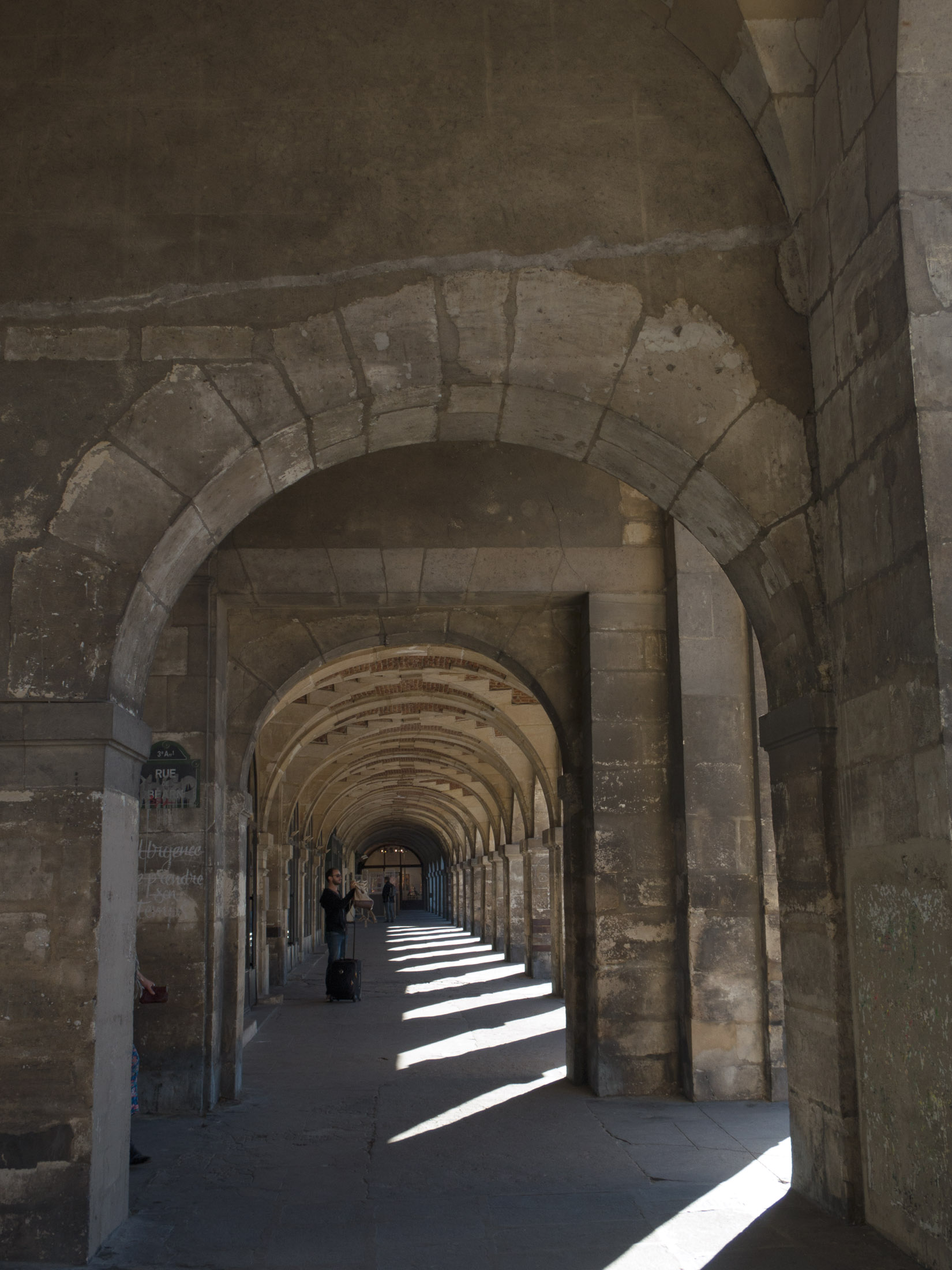

Ninon de l’Enclos: Arcades in Place des Vosges
NINON DE L’ENCLOS: VOLTAIRE’S FIRST COURTESAN
LOCATION: 34, rue des Tournelles, Hôtel de Sagonne
MÉTRO: Chemin Vert; Saint-Paul
Born in Paris in 1620, a child of a religious skeptic father and a devoutly Catholic mother—and, as an accomplished lutenist and linguist, a prodigy like Voltaire—by the time she was a teenager she’d become a much desired courtesan and salonnière in the Marais. The very beautiful Ninon received her guests and lovers (she called them Les Oiseaux des Tournelles) at her hôtel and later the Hôtel de Sagonne, just off the northeast corner of Place Royale (Place des Vosges) on rue des Tournelles. She was nicknamed Notre-Dame des Amours (Our Lady of Love).
During the reign of Louis XIV (1661–1715), her salon attracted the crème of Paris, powerful statesmen (including Madame de Sévigné’s husband and son); clergy, including Voltaire’s godfather, Abbé de Chateauneuf, and Cardinal Richelieu whose erotic interest she did not return; and artists Lully, Racine, La Fontaine, La Rochefoucauld, Boileau, and Molière. Ninon and Molière were especially close friends. Although he mocks the silly conversation of the salons and their salonnards (sycophants) in his play Les Précieuses Ridicules (The Pretentious Young Ladies) he had a warm regard for the mistress of the salon on rue des Tournelles. “Ninon has the keenest sense of the absurd of anyone I know,” he wrote. Tartuffe, his anticlerical play about hypocrites, received its first reading in her salon. Outranking her sister salonnières (Mesdames de Sablé, de Rambouillet, and de Scudéry to name a few), the brilliant and nonconformist Ninon (a story goes that refusing to get married, she withdrew to a convent as a teenager) was reputed to host the most prestigious literary salon of her era. She required originality from her guests, barred the door against pedants.
Most salons were presided over by women. As Stacy Schiff puts it, “the women of France … kept the salon, which was the equivalent of running the newspapers.” The sharing of gossip about who was doing what with whom around town, in and out of bed, was one of the salons’ most delicious party games. Political debates and new philosophical speculations added to the effervescence of the talk that sparkled until the sun came up over the rosy-colored stone and mansart roofs of the new Place Royale.
Ninon de l’Enclos was not a salonnière whose primary role was to flatter male wits or keep the hors d’oeuvres moving. Among cultural historians there is now a controversy about whether women actually contributed anything substantive to the conversation or whether they performed merely as pretty objets offering every variety of hospitality. But no one disputes that Ninon had her own ideas: “Feminine virtue,” she insisted, “is nothing but a convenient masculine invention.” She scorned organized religion, especially monastic and ascetic Christianity and the priests and bishops who denounced her amoral salon from the Sunday pulpit after enjoying themselves there on Saturday night. Her credo affirmed the primacy of pleasure and the duty to avoid pain.
All that I can say in favor of love is that it gives us a greater pleasure than any of the other comforts of life. It pulls us out of our routines and stirs us up.
Her ethical horizons focused on the renewed Epicureanism that had inflected the French Renaissance. Her disdain for Plato’s spiritual universe was matched by her enthusiasm for the earthbound essays of Montaigne.
More than for the licentiousness of her gatherings or the gossip about her serial lovers, it was for the philosophical transgressions voiced inside her salon and reported in the streets of the Marais that moved the pious Queen Anne of Austria, mother of the Sun King (Louis XIV), to send Ninon to jail for a few months. (In fact, the jail was a convent.) Mademoiselle de l’Enclos was simply too unorthodox and permissive to avoid the silencing and condemnation of the censors in royal Catholic Paris. But the memoirist Saint-Simon took notes, Ninon herself wrote letters, and over the next three centuries her reading audience was charmed.
For the Traveler
There is a white plaque on the black façade of 34, rue des Tournelles, identifying Ninon as the hôtel’s renowned philosophe and courtesan.
NINON de L’ENCLOS (1620–1705) Femme de lettres, Femme de pouvoir.
In the Hôtel de Sagonne lived one of the most powerful women of her time. Ninon de L’enclos was a philosophe and courtesan of the 17th century. In her salon she received Lully, Moliere, Racine and la Fontaine.
Location was on her side. Rue des Tournelles, opened in 1400, extending from the ancient Roman road rue Saint-Antoine on the southern end to boulevard Beaumarchais on the north, was on the site of the original royal lands of the Château des Tournelles, the royal residence where Henri II died after a jousting tournament. After his death, Henri’s queen, Catherine de Medici (choreographer of the Saint Bartholomew’s Day Massacre), had the château razed. The Tournelles district turned into a sort of dump and horse market until Henri IV, the ultimate galant urbanist (see here) orchestrated the building of the glorious Place Royale (Place des Vosges). In the hôtels of the Place and its surrounding streets—rue des Tournelles parallels the east side of the Place, rue de Turenne the west, and rue de Béarn leads north of the Queen’s Pavillion out of Place des Vosges—the city’s wealthiest and most fun-loving aristocrats settled in.
Even though Henri IV didn’t survive to enjoy the beauty or the nightlife of what Joan DeJean calls the “fun part of town,” from the outset this elegant enclave observed rituals of pleasure that would have suited Henri’s taste for good times and beautiful women: tournaments, balls, fairs, fireworks, weddings, duels, and the specialty of le grand siècle, the salon.
Perhaps Ninon got some of her nerve from the currents of change moving Paris into the “modern” world, not just inside the Marais salons but in public, under the influence of the mover-and-shaker King Louis XIV. Absolutist in the practice of statecraft, when it came to the reputation of his city, he was determined to compete with the the rival cities of Europe. Throughout his long reign, in addition to waging hugely expensive wars and persecuting Protestants, he transformed Paris into a place of public pleasures and leisure. He broadened many streets, creating the first boulevards and getting rid of the garbage that had always been thrown in the gutters; he made carriage traffic practical, added street lanterns, and, thanks to the genius of his landscape artist André Le Nôtre who turned the Tuileries into a public park and promenade, he opened this former royal preserve to the working class who lived beyond the city center. Walking became the favorite Parisian leisure activity in Ninon’s day, enabling women to show off new dresses, and both sexes to flirt.
Ninon’s Paris now became the must-see city in Europe. The Tuileries, as the “first truly public Parisian garden,” became the “prototype for public gardens” all over Europe. A twenty-minute walk to the east of it, the Place Royale was described as “the most beautiful spot, not only in Paris, but in any city in the world.”1 And women, long cloistered like nuns and drones inside what Ninon saw as their domestic marital prisons, were allowed this beauty. A friend of the prolific letter-writer Madame de Sévigné (after she forgave Ninon for sleeping with her husband and son), Ninon, no doubt, joined her on the paths through the Tuileries (and the Place) where men and women walked and drank and talked together. Madame de Sévigné described it all in her famous letters to her daughter.2
As the relaxed gender relations of the Tournelles salon moved outdoors, liberating the pleasures of the streets, parks, and the royal Places, many of the writers who lived in rue des Tournelles, rue de Turenne, and rue de Béarn and hated the idea of ever moving away wrote about the crucial role that “proximity to a beautiful spot,” such as the Place Royale, played in their daily lives.3
Ever since the era of Ninon de l’Enclos, Paris writers have sung the joy of life in a place where the marriage of beauty, pleasure, and friendship feels like love.
A biographer of 1903 described the presiding philosophe and courtesan of rue des Tournelles as:
the most beautiful woman of the seventeenth century. For seventy years she held undisputed sway over the hearts of the distinguished men of France; queens, princes, noblemen, renowned warriors, statesmen, writers, and scientists bowing before her shrine and doing her homage. Even Louis XIV, when she was eighty-five years of age, declared that she was the marvel of his reign.4
As a nine-year-old prodigy, Voltaire was taken to meet the aging Ninon who had heard about him from his godfather/her lover, the Abbé Chateauneuf. The boy recited from memory many verses of poetry. He was struck by her old wrinkled skin. Wrinkles, opined Ninon, are a sign of wisdom. She died soon after meeting Voltaire and rewriting her will to leave him a generous bequest for the purpose of buying books.
Nearby
CHEZ JANOU 2, rue Roger Verlomme and rue des Tournelles. A friendly provençal bistro and restaurant open every day, midi et soir. Tel: 01.42.72.28.41.
LE PETIT ITALIEN Entrance at 5, rue Saint-Gilles but facing rue de Béarn (the street that leads north out of Place des Vosges). Excellent food and service. A two-minute walk, through an archway, from the lovely Jardin Saint-Gilles-Grand-Veneur to the north, with stately seventeenth-century mansions. Tel: 01.42.71.05.80.
LE PETIT MARCHÉ 9, rue de Béarn. Tel: 01.42.72.06.67. Very good food and ambience on the terrace in season, looking down the street at the Queen’s Pavillion on the north end of the Place des Vosges.
HÔTEL DE SULLY 2, rue Saint-Antoine, the residence of the Duke of Sully, Henri IV’s able Calvinist finance minister. Walk straight, into the pretty orangerie. The archway in the northeast corner leads into the Place des Vosges. The excellent bookstore in the southwest corner—Librairie des Monuments Historiques—stocks books about Paris in every genre. Open Tues–Sun.
PLACE DU MARCHÉ SAINTE-CATHERINE Turn right into rue Caron as you walk west, along rue Saint-Antoine. The little street leads straight into this small square facing rue d’Ormesson. Benches and bistros under the trees. Le Marché, 2, Place du Marché Sainte-Catherine, serves good simple food in a comfortable old dining room.
MUSÉE CARNAVALET 23, rue de Sévigné. Métro: Saint-Paul. Hours: Tues–Sun, 10–5:30. Walk west from Place des Vosges across rue de Turenne, continue one block west along rue des Francs-Bourgeois until rue de Sévigné. Turn right. The Renaissance mansion of Madame de Sévigné (1626–1696)—now the Museum of Paris—where she lived for the last twenty years of her life and wrote many of the thousands of letters she is remembered for has a sculptured garden and exhibits providing a rich introduction to the history of Paris starting with the Romans. But Madame du Sévigné’s letters tell the story of life under Louis XIV like nothing else.
RUE PAYENNE Walk another block west along rue des Francs-Bourgeois and turn right into rue Payenne, a street of treasures, especially Square Georges-Cain on the right. Farther west is the heart of Marais museum country: Musée Picasso, Musée d’Art et d’Histoire du Judaïsme, Archives Nationales de France, and the Musée de l’Histoire de France (with the only contemporary portrait of Joan of Arc and Marie Antoinette’s last letter to Louis XVI).
